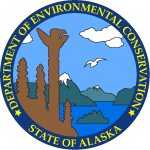| Action Date |
Action |
Description |
DEC Staff |
| 5/8/1990 |
Document, Report, or Work plan Review - other |
ADEC sent Col. Edwin Ruff letter re: USTs at Fort Richardson. Staff reviewed the draft SOPs for Site Investigation of UST removals dated April 11, 1990.
Screening Method: Soil samples collected when HNU [photoionization analyzer] readings are consistently less than 50 ppm. Recommend excavating until the readings with Hnu are non-detectable (or equal to the background readings) and then collecting soil samples for laboratory analysis.
Sample location: The department has not been accepting composite sampling from within excavation as a means of determining adequacy of cleanup. Composite sampling has been approved as a method of characterizing spoils piles after excavation.
Sample collection procedure: Sample collection jars should be obtained from the laboratory that will perform the analyses. Samples must be stored at 4 degrees celsius from the time of collection until analyzed (within 14 days of collection).
Analysis: All soil samples should be analyzed for Total Petroleum Hydrocarbons (EPA Method 418.1) and BTEX (EPA Method 8020) unless a hydrocarbon identification test (EPA Method 8015) clearly shows that the contamination is ONLY diesel or another non-gasoline fraction hydrocarbon such as heating fuel. Under these conditions, samples need only be analyzed for TPH.
If the tank was used for waste oil, soil samples should be analyzed for PCBs (EPA 8080), total arsenic, cadmium, chromium, and lead as proposed in your SOPs. If the total lead content is above allowable limit, additional sampling and analysis should be conducted following the toxic characteristic leaching procedure (TCLP). Rather than testing the soils for total organic halides by EPA Method 9020, the department is requesting analysis of total organic halides by EPA Method 8010.
If a site cannot be cleaned up adequately through the tank removal and initial excavation efforts, a site assessment may be requested including individual work plans and QA/QC plans. For the initial tank removals this letter and your SOP for tank removals, dated April 11, 1990, will suffice as a generic work plan. |
Ron Klein |
| 7/2/1991 |
Update or Other Action |
Groundwater Quality Survey No. 38-26-K986-91 Fort Richardson, AK June 24-July 2, 1991.
1. PURPOSE. This survey was performed to evaluate and update the Solid Waste Management Unit (SWMU) information contained in Fort Richardson's RCRA Facility Assessment (RFA); to determine
which Sm's require further sampling, investigation, or corrective action; and to identify and evaluate any SWMU's not previously documented.
2. CONCLUSIONS. Four of the 120 previously-identified SWMU's require sampling and analysis to verify environmental release, and 14 sites are being investigated under separate programs.
Thirty-one SWMU's are Waste Accumulation Areas (WAA's), some of which require improvements to identify, prevent, or control environmental releases. Eighteen underground storage tanks
(UST's) require no actions other than continued documentation of efforts. The two SWMSl's located at Camp Carroll should not be addressed under Fort Richardson's corrective action requirements. Based on a low potential for release and/or a lack of a susceptible migration pathway, 51 SWMU's require no further action. Six new SWMU's were identified, five of which have
ongoing or planned investigations. The remaining new SWMU requires no further action.
3. RECOMMENDATIONS. Provide the information contained in this report, along with supporting documentation for all SWMU's, to the permitting agency when issuance of the Part B RCRA permit
becomes imminent. Initiate investigative actions recommended at SWMU's 15/120, 37, and 41 to determine whether environmental releases have occurred. Implement the improvements recommended
for specific WAA's to identify, prevent, or control environmental releases. analysis, Maintain complete documentation of all sampling and remedial action, construction/removal, or investigation work associated with every SWMU. Continue with ongoing or planned investigations -at 14 original SWMUs and five new SWMUs.
SWMU Identitified in the RFA SWMU #20 Waste Accummulation Area Near Bldg. 750, SWMU #21 Oil/Water Separator #1 Near Bldg. 750, and SWMU #22 Oil/Water Separator #2 near Bldg. 750. #23 Underground Waste Oil Tank #1 near Bldg. 750 and SWMU 22 Underground Waste OIl Tank #2 near Bldg. 750.
|
Louis Howard |
| 9/4/1992 |
Site Added to Database |
Petroleum contaminant. |
Louis Howard |
| 9/2/1993 |
Update or Other Action |
Preliminary Release Investigation Report Underground Storage Tank Sites Fort Richardson, Alaska, dated July 6, 1993 received by ADEC for review and comment. The report covers the following sites:
Plate 3 Site A, Building 45590, Old Auto Hobby Shop
Plate 4 Site B, Building 750, Motor Pool
Plate 5 Site C, Building 755, Auto and Crafts Center
Plate 6 Site D, Building 756, Motor Pool
Plate 7 Site E, Building 974, Special Purpose Equipment Repair Shop
Plate 8 Site F, Building 796, Vehicle and Weapons Repair Shop
Plate 9 Site G, Building 47811, Veterinary Clinic
Plate 10 Site H, Building 47438, Bryant Anny Airfield Fuel Facility
Plate 11 Site I, Building 47641, Former Aero Club
Plate 12 Site J, Buildi ng 28004, Chlorination Facility
Plate 13 Site K, Building 955, Used POL Holding Facility |
John Halverson |
| 9/21/1993 |
Update or Other Action |
A.G. letter (Breck Tostevin) to Tamela J. Tobia, OS Judge Advocate for the Army. Letter states that a separate petroleum site compliance agreement should be separate from the CERCLA federal facility agreement. The petroleum site restoration agreement would function as a "two-party agreement" under the FFA. It would track the basic provisions of the UST Agreement but be tailored to the State's contaminated site regulations and would interface with the FFA. All petroleum sites addressed under the Two Party agreement would be reviewed in the final operable unit of the FFA and actions taken would be memorialized in a Record of Decision (ROD) under the FFA. |
Louis Howard |
| 7/18/1994 |
Update or Other Action |
July 18, 1994 UST Site Assessment Report received (OSC). For Building 750E, field screening was limited to visual inspection of the soil at the project site. Additional samples were collected to increase the potentialfor identifying petroleum contamination
that may have been released by Tank 15 at Building 750E.
Under Work Release R30206/514 issued by Brown & Root Service Corporation, Oil Spill
Consultants collected samples and performed a site assessment during the removal of a 1,000-
gallon underground storage tank (US1) at Building 750E on Ft. Richardson, Alaska. The USTwas
removed by South Fork Construction on May 10, 1994. It was taken to a storage area behind
Building 955 for cutting and cleaning. It then will be given to the Defense Reutilization and
Marketing organization for disposal.
Seven sets of samples were collected to determine if the soil over and around the UST was
contaminated with petroleum hydrocarbons. Additionally, the tank contents were sampled to
assess which contaminants would likely be in the soil if a release occurred. Samples were taken
to Commercial Testing & Engineering Co. and Analytical Technologies in Anchorage, Alaska for
analysis.
Laboratory results show that the maximum detected level of diesel range organics (ORO) in the
project soil was 104 ppm. Gasoline range organics (GRO) and benzene were detected at 1.6
ppm and 0.02 ppm, respectively. The BTEX level was detected at a high of 0.11 ppm. These
results strongly suggest that no petroleum hydrocarbons were released to the environment from
Tank 15 at Building 750E.
Based on guidelines provided in 18 AAC 78.315 and environmental conditions at Ft. Richardson,
Alaska, the soil at Building 750E qualifies for Level C cleanup which sets the maximum ORO
concentration at 1,000 ppm and the maximum GRO concentration at 500 ppm. Since the
detected levels for ORO and GRO at Building 750E are significantly lower than these levels, no
further action is required for site closure. All soil excavated during tank removal can be used for backfill pending confirmation from the Alaska Department of Environmental Conservation UST
Program.
A 1,OOO-gallon UST (Tank 15) was stored on the side of Building 750E to store water which
accumulated during vehicle washing. Tank 15 was 6 feet 2 inches long and 5 feet and 2 inches
in diameter. It had a 2 inch vent pipe and a 4 inch fill pipe. Both pipes extended 3 feet above
the ground. This UST was installed approximately 4 feet below ground and had no surface
dispensers.
On May 10, 1994, Tank 15 was removed by South Fork Construction. It was placed on a liner
prior to being taken to the storage area next to Building 955 for cleaning. Following cleaning, the tank will be turned in to DRMO for disposal. Tank 15 did not have hold-down pads or anchoring devices. It was in good condition. There was no corrosion or damage which would indicate that fluid had leaked from this tank.
Approximately 22 cubic yards of overburden were excavated prior to removing the tank. Although
petroleum stains were found in the soil around the tank's fill pipe, a detailed inspection of the overburden and the soil remaining in the excavated area by Oil Spill Consultants' Environmental Engineer revealed no other signs of petroleum contamination. No moisture or liquids entered the excavation after the tank was removed.
Analyses: GRO 8015M, DRO 8100M, TPH 418.1 and BTEX 8020.
Maximum benzene and GRO levels were detected at 0.02 ppm and 1.6 ppm for the soil samples
for Tank 15. BTEX was detected at 0.11 ppm. The ORO level for the background sample was
104 ppm. By comparison, the ORO level ranged from a low of 4.0 ppm to a high of 68 ppm for
the soil over and around Tank 15.
As discussed in Section 2.2, the liquid in Tank 15 was sampled by Oil Spill Consultants on May
10, 1994. This liquid was determined to be water with trace quantities of petroleum hydrocarbons.
The flash pOint for the liquid In this tank was greater than 200°F.
The visual screening of the project soil supported by laboratory data indicates that no releases
have occurred from Tank 15. Since the maximum detected level of ORO in the soil under the
tank was only 13.6 ppm, it is reasonable to conclude that the tank 15 has not leaked. Higher
ORO level in the background sample probably indicates that surface spills might have occurred
in the soil around Building 750E.
No further action is required for site closure. The overburden removed during site excavation can be used for backfill at the project site. |
Louis Howard |
| 7/19/1994 |
Update or Other Action |
Site Assessment report received for 750W.
Under Work Release R30206/514 issued by Brown & Root Service Corporation, Oil Spill
Consultants collected samples and performed a site assessment during the removal of a 1,000-
gallon underground storage tank (UST) at Building 750W on Ft. Richardson, Alaska. The UST
was removed by South Fork Construction on May 10, 1994. It was taken to a storage area
behind Building 955 for cutting and cleaning. Following this, it will be given to the Defense
Reutilization and Marketing organization for disposal.
Seven sets of samples were collected to determine if the soil over and around the UST was
contaminated with petroleum hydrocarbons. Additionally, the tank contents were sample~ to
assess which contaminants would likely be in the soil if a release occurred. Samples were taken
to Commercial Testing & Engineering Co. and Analytical Technologies in Anchorage, Alaska for
analysis.
Laboratory results show that the maximum detected level of diesel range organics (ORO) in the
soil under the storage tank was 22.7 ppm. The DRO level in the overburden was 96 ppm.
Gasoline range organics (GRO) and benzene were detected at 10.6 ppm and 0.02. ppm,
respectively. The BTEX level was detected at a high of 0.195 ppm. These results strongly
suggest that no significant quantities of petroleum hydrocarbons were released to the
environment from Tank 16 at Building 750W.
Based on guidelines provided in 18 AAC 78.315 and environmental conditions at Ft. Richardson,
Alaska, the soil at Building 750W qualifies for Level C cleanup which sets the maximum ORO
concentration at 1,000 ppm and the maximum GRO concentration at 500 ppm. Since the
detected levels for ORO and GRO at Building 750W are significantly less than these levels, no
further action is required for site closure. All soil excavated during tank removal can be used for backfill pending confirmation from the Alaska Department of Environmental Conservation UST
Program.
A 1,OOO-galion UST (Tank 16) was stored on the North side of Building 750W to collect water from
vehicle washing. Tank 16 was 6 feet 1 inch long and 5 feet and 3 inches in diameter. It had a
2 inch vent pipe and a 4 inch fill pipe. Both pipes extended 3 feet above the ground. This UST
was installed approximately 4 feet below ground and had no surface dispensers.
Information provided by Brown and Root stated that Tank 16 contained water and detergents. To
verify this information a composite sample from the USTs at Buildings 750E and 750W was taken
by Oil Spill Consultants on April 18, 1994. Laboratory analysis showed that this tank contained
water with trace quantities of BTEX. No PCBs or halogenated hydrocarbons were detected. The
flash point was greater than 200 of. (This tank was emptied by a vacuum truck prior to project
startup.)
There was no stressed vegetation or other surface conditions which would indicate previous
surface spills near the USTs.
On May 10, 1994, Tank 16 was removed by South Fork Construction. It was placed on a liner
prior to being taken to the storage area next to Building 955 for cleaning. Following this, it will be turned in to DRMO for disposal.
Tank 16 did not have hold-down pads or anchoring devices. It was in good condition. There was
no corrosion or damage which would indicate that fluid had leaked from this tank.
Approximately 20 cubic yards of overburden were excavated prior to removing the tank. Although
petroleum stains were found in the soil around the tank's fill pipe, a detailed inspection of the overburden and the soil remaining in the excavated area by Oil Spill Consultants' Environmental Engineer revealed no other signs of petroleum contamination. No moisture or liquids entered the excavation after the tank was removed.
Analyses was GRO 8015M, DRO 8100M, TPH 418.1 and BTEX 8020. |
Louis Howard |
| 7/25/1994 |
Update or Other Action |
Soil samples collected during removal of the USTs 15 and 16 were found to be below Level "C" criteria (500 mg/kg GRO, 1000 mg/kg DRO, 50 mg/kg BTEX). |
Louis Howard |
| 8/8/1994 |
Update or Other Action |
Staff sent letters to the Army re: Site Assessments for UST 15 (750E) and 16 (750W) received on July 25, 1994.
Based on the data presented in the documents, ADEC concurs with the recommendations for site closure. The sites closures will be considered final contingent upon the additional sampling that will confirm the presence or absence of soil contamination above level "C" criteria. |
Louis Howard |
| 8/19/1994 |
Document, Report, or Work plan Review - other |
Results From Additional UST Soil PID Screening! Analyses comment letter sent to Army (S. Swearingen).
The Department of Environmental Conservation, Defense Facilities Oversight group,
(ADEC) has received a fax of the document listed above on August 19, 1994. The analytical
results for bldgs. 750E, 750W, 778, 784, 812, 980, 45726, and 55295 show levels well
below the most stringent cleanup criteria. ADEC considers the UST sites closed out.
However, closing out these sites does not limit nor preclude ADEC from requesting future
remediation or site investigation at a later date. If new information indicates that there is
previously undiscovered contamination or exposures that causes an increased risk to human
health or the environment, then future investigation and/or remedial actions will be required. |
Louis Howard |
| 2/5/1995 |
Update or Other Action |
Letter from the Army to ADEC. On January 13, 1995, you met with Mr. Samuel P. Swearingen, and Major Kevin Gardener of the Environmental Compliance Branch. At this time you requested an explanation for the lack of spill protection on a number of underground storage tanks(UST) located at Fort Richardson. Below you will find a listing of those regulated tanks that were in question and an explanation of how the spill control requirement is met:
Tank # 108A-This is a used oil UST with an ILS-350 interstitial monitor/overfill alarm system. The tank's spill control is a catchement basin(s)lfloor drain system attached to an oil water separator. The tank is filled through manually pouring oil into either one of the floor drains or into an oil sink. The system is nonpressurized, and gravity fed. |
Louis Howard |
| 6/16/1995 |
Site Ranked Using the AHRM |
Initial ranking. Action code added because it wasn't when the site was originally ranked. |
Louis Howard |
| 1/10/1997 |
Update or Other Action |
Army provides a decision document discusses and records the rationale for No Further Remedial Action Planned (NFRAP) at Bldg 750, Fort Richardson. Removal of the underground storage tanks at this site was required by the FRA UST Compliance Agreement. The levels of contamination found at the site during removal were all below current acceptable standards (Level "B").Building 750, located at the intersection of Richardson Drive and Second Street, is the Motor Pool for 1st/501st Airborne.
Underground storage tanks (UST) 15 and 16 were removed and replaced with new double walled tanks in May 1994. Soil samples taken during the tank removal were found to contain low levels of petroleum products (above level "A" but below level "B"). Evaluation of remedial alternatives was not conducted for this site. Residual contamination levels at the site did not require a release investigation, development of human health risk based closure levels, or a corrective action plan. |
Louis Howard |
| 7/2/1997 |
Update or Other Action |
US Army Environmental Hygiene Agency, Groundwater Quality Survey number 38-26-K986-91, evaluation of which solid waste management units (SWMUs) identifed in the RCRA Facility Assessment (RFA), 120 are listed, require further sampling, investigation, or corrective action; and to identify and evaluate any SWMU's not previously documented. This includes SWMU 21 - Oil/Water Separator #1 near Bldg. 750, SWMU 22 - Oil/Water Separator #2 near Bldg. 750, SWMU 23 underground waste oil tank #1 near bldg. 750, and SWMU 24 underground waste oil tank #2 near bldg. 750.
A SWMU is considered any unit intended for waste management or receiving routine systemic, and deliberate discharge of wastes. Typical SWMUs include landfills, waste impoundments, waste tanks, waste storage areas, wastewater and sewage treatment plants (STPs), and incinerators. |
John Halverson |
| 9/10/1998 |
Update or Other Action |
Site Assessment Report UST Removal Fort Richardson, Alaska Building 750 - Tank 16A. Under Work Release No. R70088/182, issued by Brown & Root Services Corporation. Oil Spill Consultants, Inc. collected samples and performed a site assessment during the removal of Tank 16A at Building 750 on Fort Richardson, Alaska.
Tank 16A is a 1,000 gallon underground storage tank which was installed at Building 750
to collect waste oil. It was 7'2° long, and 5'4" in diameter. This UST was installed
approximately 4' below ground and had no surface dispensers. The soil removed to access Tank 16A was used to backfill the excavation. About six cubic yards of clean soil were imported and used to raise the excavated area to grade. An analysis of the contents revealed that Tank 16A contained oily water. After being removed, Tank 16A was taken to Newell Recycling Alaska for disposal. Four quality control samples and six project samples were collected to determine if the soil over and around Tank 16A was contaminated with petroleum hydrocarbons.
Since no PID readings were obtained during field screening, stockpile samples were collected from the 5th cubic yard of soil and the 15th cubic yard of soil that was excavated. Following State of Alaska guidelines, samples were collected from the soil which was 1 ft. below the center of the tank and the soil 1 ft. below the end of the tank closest to the fill pipe. Pipe trench sample was collected from the soil 4 ft. below the surface at a distance of 8 ft. from Tank 16A.
Lab analyses was for GRO (none detected), DRO (11.4 mg/kg), RRO (57.7 mg/kg), benzene (ND), Total BTEX (ND). PCB (ND), Metals: Arsenic 3.98 mg/kg, cadmium 1.13 mg/kg, chromium 45 mg/kg, lead 89.7 mg/kg. No further work is required for site closure. All overburden excavated during tank removal was used for backfill at the project site.
|
Tim Stevens |
| 3/10/1999 |
Conditional Closure Approved |
ADEC sent letter to Army RE: The May 13, 1998, closure of Underground Storage Tank (UST), Alternate ID 16A, located on the north side of building 750, Fort Richardson, Alaska. Facility ID 0-000788, ADEC tank 153. Event Id 2274.
The report was received on August 13, 1998, documenting the closure of the above mentioned underground storage tank (UST). It summarizes the information collected during closure of the 1000-gallon UST that was used to store used oil at Building 750. Since, both the UST closure and the site assessment report were completed prior to the adoption of the January 22, 1999 regulations, ADEC conducted its review of the site assessment report using the November 3, 1995 regulations, in effect at the time of the closure. Based on the information and laboratory data presented in the site assessment document, no further action is required by ADEC.
Please note, ADEC believes the consultant errored in determining the matrix score of 26 for this site. Based on the volume of excavated contaminated overburden (20 cy later used to backfill the UST excavation), and the unknown volume of contaminated soil left in place at the bottom of the UST excavation, 31 is a more appropriate matrix score. A matrix score of 31 equates to a category “B” site, which has more stringent cleanup standards than a category “C” site. However, since the levels of contamination found were below category “B” cleanup standards, the change in the matrix score does not alter ADEC’s decision for no further action required.
In the future, should contaminated soil or groundwater be discovered on site that exceeds State cleanup standards, appropriate site assessment and cleanup would be required of the Army in accordance with applicable State regulations. |
Tim Stevens |
| 12/12/2001 |
Institutional Control Record Established |
1. All organizations conducting activities on Post are responsible for complying with established institutional controls (ICs). They are applicable to all known or suspected contaminated sites where contamination has been left in place above those which do not allow for unrestricted use.
2. ICs such as limitations on access, excavations, and property transfers will supplement engineering controls as appropriate for short and long-term management to prevent or limit human and environmental exposure to hazardous substances, pollutants, or contaminants. Specific ICs include, among other things: limitations on the depth and location of excavations, requirements for worker use of personal protective equipment, site monitoring, and prohibition of certain land uses, types of vehicles, etc.
3. Organizational units, tenants, and support/contractor organizations must obtain an Excavation Clearance Request (ECR) for all soil disturbing activities impacting soils six inches or more below the ground surface. The review process for approval of an ECR begins with the identification of the current status (known or suspected hazardous waste site or “clean” site) of a work location. ECRs for work in known or suspected hazardous waste sites: a. will include specific limitations and controls on such work; b. will include specific IC procedures, and notification, monitoring, reporting, and stop work requirements; c. may include procedures for management, characterization, and disposal of any soil encountered or removed; d. will identify project managers for both the unit/contractor requesting the work and DPW Environment Resources.
4. DPW will conduct on-site inspections of each work site (at which ICs apply) to determine continued compliance with the terms and conditions of the approved ECR. DPW has the authority to revoke ECR approval if the specified terms and conditions are not being met.
|
Louis Howard |
| 4/8/2013 |
Update or Other Action |
Draft site closure report received for review and comment.
The purpose of this Site Closure Report is to document that TU046 – Building 750 (FTRS-46)
(CS DB Hazard ID 1233) at Joint Base Elmendorf-Richardson (JBER)-Richardson (JBER-R), Alaska, meets the following objectives and requirements:
Is protective of human health and the environment in accordance with the Alaska Department of Environmental Conservation (ADEC) contaminated sites (18 Alaska Administrative Code [AAC] 75) and underground storage tank (UST) regulations (18 AAC 78) (ADEC, 2012a and 2012b);
Meets state requirements that are applicable or relevant and appropriate;
Is suitable for unrestricted use; and
Meets site closeout requirements as defined by the United States Air Force.
With the approval from ADEC and agreement that levels of contamination no longer present a
significant threat to human health and the environment, TU046 is therefore eligible for site
closure.
This report was developed in accordance with Department of Defense Environmental Restoration Program site closeout protocol and in accordance with 18 AAC 75.380 final reporting requirements for site closure.
Cleanup Complete without institutional controls is being requested based on the determination by ADEC that there is no unacceptable risk or threat to human health and the environment. Concentrations of petroleum hydrocarbons detected in soils after the excavation and removal of
USTs 15 and 16 are below the ADEC Method Two criteria. No further action for soil was granted by ADEC on August 8, 1994. Groundwater was not encountered during UST removal and excavation, and the soil confirmation sample results are below the ADEC Method Two migration to groundwater cleanup levels.
Therefore, TU046 has been adequately characterized and addressed under 18 AAC 75 and 18 AAC 78, and Cleanup Complete with site closure is appropriate |
Louis Howard |
| 4/19/2013 |
Document, Report, or Work plan Review - other |
The Alaska Department of Environmental Conservation (ADEC) has received the above document on April 8, 2013, via electronic mail, for review and comment. ADEC has completed a review of the document and file information associated with Building 750 CS DB Hazard ID 1233 at JBER-Richardson. Based on the information provided to date, ADEC has determined the site has been adequately characterized under 18 AAC 75.335 and has achieved the applicable requirements under the site cleanup rules. One minor comment: 2.1 Site Location, please add latitude and longitude coordinates for the TU046 in decimal degree format with a precision of six decimal places (dd.dddddd).
Based on the information available, ADEC has determined that cleanup is complete, subject to a future ADEC determination that the cleanup is not protective of human health, safety, or welfare or of the environment.
ADEC approval is required for off-site soil disposal in accordance with 18 AAC 75.325(i). It should be noted that movement or use of potentially contaminated soil in a manner that results in a violation of 18 AAC 70 water quality standards is unlawful. Upon incorporation of the requested location information, the document can be finalized for signature. |
Louis Howard |
| 6/10/2013 |
Exposure Tracking Model Ranking |
Initial ranking with ETM completed for source area id: 72212 name: auto-generated pm edit Ft. Rich Bldg. 750 UST 108 |
Louis Howard |




